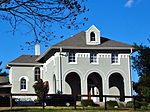John S. Russwurm House
The John S. Russwurm House is a house with Federal architecture, dating from 1819, in Triune, Tennessee that was listed on the National Register of Historic Places in 1988.The listing was for one contributing building on a 1.4 acres (0.57 ha) that also included are two non-contributing buildings.It was built by John Russwurm, an early settler of the Williamson County. As of a 1988 study, the house was deemed to be the best surviving example of either a single or double cell brick residence from its era. It was built first as a one-story brick residence, and "was later enlarged with a two-story double, cell addition. This double cell arrangement is the only remaining example of this type of construction in Williamson County.": 38 The Constantine Sneed House, also NRHP-listed, seems to have had a double cell plan but has since been altered.: 38 The Russwurm house was delisted from the National Register on November 18, 2011. Delistings usually occur after a building has been demolished or otherwise lost historic integrity.
Excerpt from the Wikipedia article John S. Russwurm House (License: CC BY-SA 3.0, Authors).John S. Russwurm House
Spanntown Road,
Geographical coordinates (GPS) Address Nearby Places Show on map
Geographical coordinates (GPS)
| Latitude | Longitude |
|---|---|
| N 35.8625 ° | E -86.643611111111 ° |
Address
Spanntown Road
Spanntown Road
Tennessee, United States
Open on Google Maps



